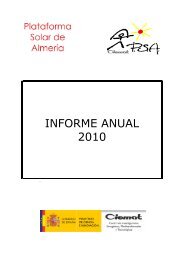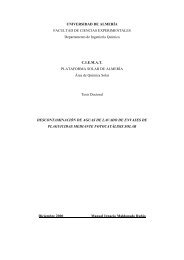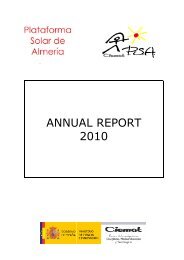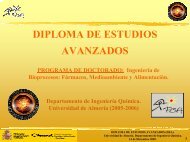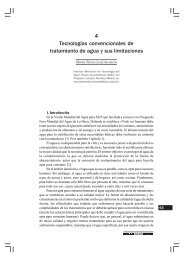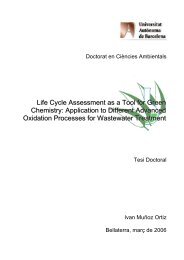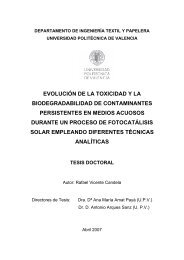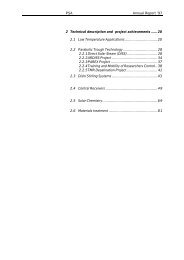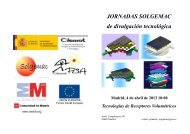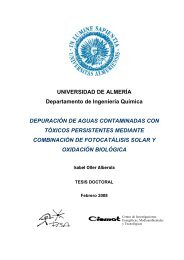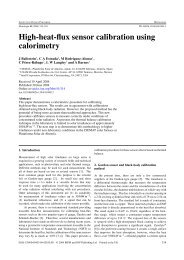Annual Report 2006 - Plataforma Solar de AlmerÃa
Annual Report 2006 - Plataforma Solar de AlmerÃa
Annual Report 2006 - Plataforma Solar de AlmerÃa
You also want an ePaper? Increase the reach of your titles
YUMPU automatically turns print PDFs into web optimized ePapers that Google loves.
ENVIRONMENTAL APPLICATIONS OF SOLAR ENERGY<br />
Figure 4.7<br />
Degradation of Fusarium equiseti spores (left) and Fusarium verticillioi<strong>de</strong>s (right)<br />
by solar irradiation and solar photocatalysis with TiO 2 in suspension (35 mg/L)<br />
un<strong>de</strong>r natural solar radiation at the <strong>Plataforma</strong> <strong>Solar</strong> <strong>de</strong> Almería (right [4.5]).<br />
conventional chemical disinfectants (toxic and nonbio<strong>de</strong>gradable compounds)<br />
which contribute a certain level of un<strong>de</strong>sirable toxicity to the nutritive water<br />
solution. Photocatalytic treatment Effectiveness of the photocatalytic treatment<br />
will be evaluated using mo<strong>de</strong>ls present in horticultural crops in the<br />
Spanish Southeast: Pythium aphani<strong>de</strong>rmatum, the cause of root rot and hypocotyl<br />
rot, which leads to wilting in cucurbits, Phytophthora parasitica, which<br />
causes root rot and tomato end rot, Fusarium oxysporum f.sp. radiciscucumerinum,<br />
fungi excluding zoosporangium (water mold), which causes<br />
significant losses wherever it appears and Olpidium bornovanus, vector of the<br />
melon necrotic spot virus (MNSV) on melon and watermelon plants. Experimental<br />
confirmation of capacity for photocatalytic disinfection of these pathogens<br />
will be done in the laboratory and at pilot scale, in the solar reactors at<br />
the <strong>Plataforma</strong> <strong>Solar</strong> <strong>de</strong> Almería facilities. Finally, the results will be tested in<br />
a crop in non-recirculating systems typical at the University of Almería experimental<br />
facilities.<br />
Purposes:<br />
• Laboratory study of elimination of mo<strong>de</strong>l phytopathogenic microorganisms<br />
in crops in non-recirculating nutritive solution by solar photocatalysis<br />
with TiO 2 (in suspension and supported) and with photo-Fenton.<br />
• Design and construction of a pilot solar reactor for disinfection of water<br />
with the above-mentioned phytopathogenic microorganisms for application<br />
in the reuse of water used in recirculating hydroponic cultures.<br />
• Evaluation of the results of treatment of phytopathogens in water from<br />
photocatalysis using mo<strong>de</strong>l phytopathogens from different types of<br />
crops normally grown without soil.<br />
• Demonstration of the feasibility of photocatalysis for disinfection of<br />
polluted water from nutritive solutions in hydroponic cultures will be<br />
carried out in the laboratory and at pilot scale in the solar reactors at<br />
the facilities of the <strong>Plataforma</strong> <strong>Solar</strong> <strong>de</strong> Almería. Finally, the results will<br />
be tested in a recirculating hydroponic crop typical of the University of<br />
Almería’s experimental facilities.<br />
Objectives achieved in <strong>2006</strong>: The first experiments on solar photocatalytic<br />
<strong>de</strong>gradation with TiO 2 and solar inactivation without catalyst were carried out<br />
at the PSA with Fusarium equiseti spores. “Batch” reactors are used for this<br />
without concentration with natural solar irradiation times of 6 hours on perfectly<br />
clear days. The results show an important effect of the solar radiation<br />
on the viability of the F. equiseti spores. The use of titanium dioxi<strong>de</strong> (P25) as<br />
a catalyst shows a noticeable improvement in disinfection efficiency (Figure<br />
81



